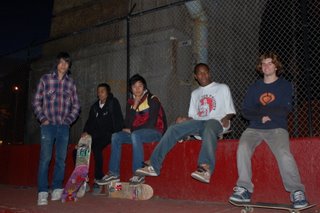A World-Class Exhibit Sits Empty on Water Street

Our Town downtown
November 20, 2006
Lonely seaside watercolors in a lonely seaside gallery
I’ve been at the office late at night, drinking Red Bull to the non-sound of sleeping computers, I’ve eaten at an Indian restaurant at 5 p.m. and been the only object of a hovering waiter’s attention, and last season I went to a Knicks game at Madison Square Garden.
But I have never felt as alone in Manhattan as I did last Tuesday afternoon, as I wandered the deserted one-room gallery at 241 Water Street, gazing at one after another lonely watercolor by renowned painter Barbara Ernst Prey.
One of Ernst’s paintings hangs in the White House, and she is the only living American painter with a work on exhibit at the U.S. Embassy in Paris. She has been called “maybe the most widely viewed painter in the world” by the New Yorker. But not here, at the Seaman’s Church Institute.
“We’re kind of off the beaten path,” says a middle-aged man who greeted me at the front desk. “If we were in SoHo…”
It is not only the three empty tables and twelve empty chairs set up for lively discussion that made me feel so eerily alone, it was the paintings themselves.
In thirty-five paintings depicting seaside life in Maine, there are only two human figures. Both are fishermen in coveralls. One, the subject of a large portrait called “The Mender,” is repairing a fishing net. His features are unformed and his eyes are obscured beneath thr brim of a baseball cap, which is covered by the hood of a sweatshirt. The other, a mere half-inch in height, is leaning away from the viewer, over the side of his fishing boat in a miniature painting maybe six by eight inches.
A theme that ties many of the paintings together is that humans are deliberately absent, a tactic that may stem from the first painting Ernst did after 9/11. Titled “Ladies in Red,” the watercolor depicts two empty red chairs overlooking the water. Their occupants would not be returning.
But this series, “Works on Water,” is not meant to be sad. In an interview with a cultural correspondent for the L.A. Times, Ernst said of her inanimate subjects: “Oftentimes I know the people. Or, if it is a house, I know the people who live inside. So for me it is a type of portrait, it’s not just the house. It’s the personal connection to the house.”
The portrait is more universal without a human image, Prey has explained. Human figures would become the focal point and, in Prey’s words, “stop the viewer.”
Still, the paintings with no people can be sad, and a little unnerving.
There is not a whole lot of difference between “Ladies in Red” and “Family Portrait,” in which six empty red chairs, and a footrest and a table, are clustered on a hilltop under a white sky. Five are facing the same direction; the sixth is askew, as if its occupant got up in a hurry and almost knocked it over. The family may be on their way back home after a playful afternoon picnic. Or – the white sky and the nearly toppled chair make it hard to avoid thinking it – their chairs may be empty for a more macabre reason.
There is not the ominous undertone in the painting “Early Risers” that can be felt in “Family Portrait,” and yet the two empty chairs half-facing each other on a front porch, where two early risers will presumably soon be sitting, comprise an isolating image. The warm yellow lights are on in the house in the foreground, and two quilts blow on a clothesline out back, so all appears to be well, but the viewer is cut off from what must be a cozy breakfast scene inside. We are not allowed even a glimpse through the lit windows.
The result is that the viewer is left with a vague kind of yearning to be connected to the people inside, to know more about them, especially what’s keeping them from occupying their places in their chairs or . The lack of personal connection makes us linger long in front of each painting, and the loneliness that it provokes stays with us long after we have left the gallery.
As I passed the suits on lunch break, and descended into the subway, my heart was still in my throat. Maybe I was still getting over the unusual feeling of having been all alone for over an hour in silence broken only by a faraway vacuum cleaner, or maybe I was still worrying over the six empty red chairs.

